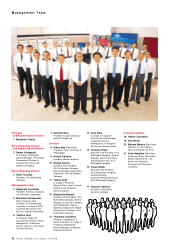JVC 2005 Annual Report Download - page 40
Download and view the complete annual report
Please find page 40 of the 2005 JVC annual report below. You can navigate through the pages in the report by either clicking on the pages listed below, or by using the keyword search tool below to find specific information within the annual report.
38 Victor Company of Japan, Limited
Cash Flows
Net cash used in operating activities amounted to ¥6.2 bil-
lion, compared with an inflow of ¥40.7 billion in the previous
fiscal year. This was mainly attributable to a decline in
income before income taxes and minority interests, special
retirement payments associated with structural reform, and
a decrease in notes and accounts payable.
Net cash used in investing activities came to ¥13.9 bil-
lion, down from ¥15.8 billion in the previous fiscal year, pri-
marily due to purchases of property, plant and equipment
amounting to ¥26.8 billion, which outweighed proceeds
from sales of investment securities of ¥5.5 billion.
Net cash used in financing activities totaled ¥15.6 billion,
up from ¥9.4 billion in the previous fiscal year. This was
largely a result of a ¥17.0 billion outflow attributable to
repayments of long-term loans and the redemption of
bonds, which countered a ¥3.7 billion increase in short-
term bank loans, net.
As a result, cash and cash equivalents at the end of fiscal
2005 came to ¥62.7 billion, down ¥34.6 billion from the end
of the previous fiscal year.
¥342.9 billion, mainly owing to a ¥38.7 billion decrease in
cash and time deposits. Major factors contributing to the
decline in cash and time deposits are described in the fol-
lowing cash flows section. Property, plant and equipment
rose ¥6.7 billion, to ¥96.2 billion, mainly reflecting invest-
ments related to the new technology center and the pro-
duction of D-ILA devices. Investments and advances
decreased ¥6.0 billion, largely as a result of the sale of
investment securities.
Total liabilities fell 11.4%, or ¥39.2 billion, to ¥304.4 bil-
lion. Although current liabilities rose ¥18.5 billion, to ¥255.1
billion, notes and accounts payable declined ¥21.8 billion,
and convertible bonds and bonds due within one year
increased ¥25.1 billion. Total long-term liabilities dropped
¥57.7 billion, to ¥49.4 billion, mainly as a result of a ¥56.0
billion decline in bonds and long-term debt.
Stockholders’ equity edged down 0.7%, or ¥1.1 billion,
to ¥158.2 billion; however, stockholders’ equity as a per-
centage of total assets rose to 33.9%, compared with
31.4% at the previous fiscal year-end.
























